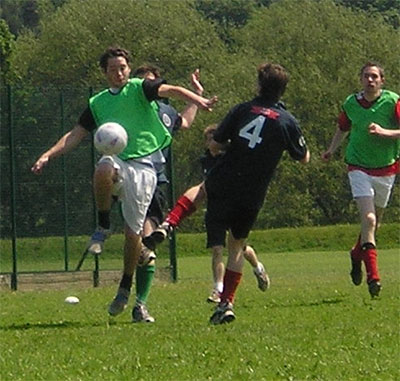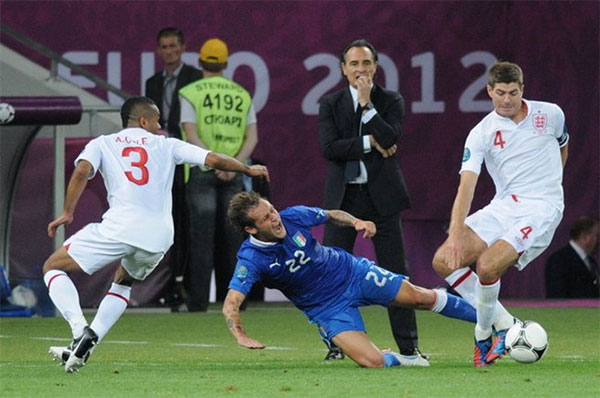♣ Tackle (football move)
Most forms of football have a move known as a tackle. The primary purposes of tackling are to dispossess an opponent of the ball, to stop the player from gaining ground towards goal or to stop them from carrying out what they intend.
The word is used in some contact variations of football to describe the act of physically holding or wrestling a player to the ground. In others, it simply describes one or more methods of contesting for possession of the ball. It can therefore be used as both a defensive or attacking move.
▲ A tackle in association football
♣ Name origin
In Middle Dutch, the verb tacken meant to grab or to handle. By the 14th century, this had come to be used for the equipment used for fishing, referring to the rod and reel, etc., and also for that used in sailing, referring to rigging, equipment, or gear used on ships. By the 18th century, a similar use was applied to harnesses or equipment used with horses. Modern use in football comes from the earlier sport of rugby, where the word was used in the 19th century.
♣ Association football
Unlike other codes, tackles in association football have to be predominantly directed against the ball rather than the player in possession of it. This is achieved by using either leg to wrest possession from the opponent, or sliding in on the grass to knock the ball away. A defender is permitted to use their body to obstruct the motion of a player with the ball, and this may be part of a successful tackle. Pulling a player to the ground in the style of tackle common to other codes is completely absent from the game (this would be considered "violent conduct" and result in a red card (dismissal)).
Although some contact between players is allowed, the rules of association football significantly limit the physicality of tackles, explicitly forbidding contacts which are "careless, reckless or [use] excessive force". Almost all tackles where the tackler's legs make contact with the opponent before the ball are considered illegal, and heavy contact after initially touching the ball may also be penalised.
Illegal tackles are fouls and are punished with a direct free kick (or penalty if committed within the penalty area) for the opponent's team. Such incidents are common, with dozens of occurrences in a typical match. In most cases these fouls are not considered misconducts, however yellow cards (cautions) may be delivered for more egregious fouls that constitute "unsporting behaviour". If a foul tackle endangers the tackled player's safety, it is likely to be considered as "serious foul play" by the referee and punished with a red card (dismissal).
Tackles that involve lunging at an opponent with both legs, regardless of whether the ball is won, are generally considered to constitute serious foul play and hence result in a sending-off. This explicitly includes "scissoring" (tackling with legs apart, so as to trap the opponent's leg or legs in between), which is likely to be punished with a sending-off (red card), as it poses a high risk of severe knee injury to the player being tackled. Tackling with studs up is considered dangerous. A studs up tackle is made when a player lunges into a tackle with a leg or both legs outstretched exposing the soles of their boots. Referees are encouraged to at the very least caution (yellow card) players who commit such challenges.
Additionally, an illegal tackle which is also a professional foul is considered misconduct.
▲ Alessandro Diamanti (22) slide tackles Steven Gerrard (4) at Euro 2012
The most spectacular form of tackle in association football is the slide tackle, wherein a tackler slides, leg extended, along the ground, aiming to hit the ball away. This form of tackle carries a high risk of committing a foul.
"Diving" in association football involves tackled players exaggerating the physicality of tackles, so as to gain favourable decisions from the referee.
♣ Sliding tackle
A sliding tackle, also called slide tackle, is a tackle in association football in which one leg extends to push the ball away from the opposing player. Sliding tackles can often be sources of controversy, particularly when players being tackled fall down over the tackler's foot (or the ball stopped by the tackler's foot), and penalties, free kicks and cards are assessed (or are conspicuous by their absence).
▲ Sliding tackle performed by player in blue (Mohammad Daneshgar).
♣ Commonly associated fouls and misconduct
A sliding tackle is not in itself foul play; however, there are a number of fouls that commonly occur during the execution of a sliding tackle.
Examples of such fouls punishable by a direct free kick or penalty kick include:
-
When a player behaves in a manner considered by the referee to be careless, reckless or using excessive force:
-
kicks or attempts to kick an opponent;
-
trips or attempts to trip an opponent;
-
jumps at an opponent;
-
charges an opponent;
-
tackles an opponent.
Careless means that the player has shown a lack of attention of consideration when making a challenge or that he acted without precaution. Reckless means that the player has acted with complete disregard to the danger to, or consequences for, his opponent. Using excessive force means that the player has far exceeded the necessary use of force and is in danger of injuring an opponent.
Careless challenges are punished by only a direct free kick or penalty kick. However, reckless challenges are also punished with a caution (yellow card) for unsporting behaviour as well as a direct free kick or penalty kick, while challenges committed with excessive force are also punished with a send-off (red card) for serious foul play as well as a direct free kick or penalty kick.
Playing in a dangerous manner is punishable by an indirect free kick. Playing in a dangerous manner is defined as any action, that while trying to play the ball, threatens injury to someone (including the player himself). It is committed with an opponent nearby and prevents the opponent from playing the ball for fear of injury. If any physical contact is made, the offence becomes an offence punishable with a direct free kick or penalty kick.
Slide tackles that are made as two-footed lunges at an opponent are generally considered to endanger the safety of an opponent and are hence sanctioned as serious foul play, resulting in a sending-off. This is still the case even if the ball is won cleanly without touching an opponent.
♣ Strategy
The slide tackle is attractive to the defender because it allows him to cover a larger area of ground while attempting to dispossess an opponent. It is often a "last-ditch" attempt to dispossess an opponent due to frequent misses and the difficulty of recovering in the event that the slide tackle fails to take the ball away. After a slide tackle, the tackler is left sitting or lying on the ground with one leg extended. The tackler therefore also runs the risk of personal injury. Ideally, the other foot ends up folded underneath their rear end, where it can be used to push the tackler back up to their feet to continue play.
If doing a sliding tackle to the right, the player's right leg must be straight when going down into the tackle and their left leg should be bent slightly behind the right one in order to achieve maximum potential in gaining the ball. If doing a sliding tackle to the left, the player's left leg must be straight and their right leg should be bent behind the left one.
 Premier League
Premier League La Liga
La Liga Bundesliga
Bundesliga Serie A
Serie A Ligue 1
Ligue 1 Liga Portugal
Liga Portugal Eredivisie
Eredivisie Süper Lig
Süper Lig MLS
MLS Série A
Série A J1 League
J1 League Saudi Pro League
Saudi Pro League WSL
WSL Première Ligue
Première Ligue NWSL
NWSL







 Chapter 13. football (Soccer) tactics and skills > Tackle (football move) & Sliding tackle
Chapter 13. football (Soccer) tactics and skills > Tackle (football move) & Sliding tackle


 •Wikipedia
•Wikipedia








